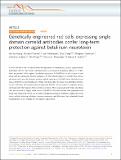| dc.contributor.author | Huang, Nai-Jia | |
| dc.contributor.author | Mukherjee, Jean | |
| dc.contributor.author | Zhang, Sicai | |
| dc.contributor.author | Shoemaker, Charles B. | |
| dc.contributor.author | Pishesha, Novalia | |
| dc.contributor.author | Deshycka, Rhogerry | |
| dc.contributor.author | Sudaryo, Valentino | |
| dc.contributor.author | Lodish, Harvey F | |
| dc.contributor.author | Dong, Min, 1968- | |
| dc.date.accessioned | 2017-12-12T14:46:21Z | |
| dc.date.available | 2017-12-12T14:46:21Z | |
| dc.date.issued | 2017-09 | |
| dc.date.submitted | 2016-10 | |
| dc.identifier.issn | 2041-1723 | |
| dc.identifier.uri | http://hdl.handle.net/1721.1/112702 | |
| dc.description.abstract | A short half-life in the circulation limits the application of therapeutics such as single-domain antibodies (VHHs). We utilize red blood cells to prolong the circulatory half-life of VHHs. Here we present VHHs against botulinum neurotoxin A (BoNT/A) on the surface of red blood cells by expressing chimeric proteins of VHHs with Glycophorin A or Kell. Mice whose red blood cells carry the chimeric proteins exhibit resistance to 10,000 times the lethal dose (LD 50 ) of BoNT/A, and transfusion of these red blood cells into naive mice affords protection for up to 28 days. We further utilize an improved CD34+ culture system to engineer human red blood cells that express these chimeric proteins. Mice transfused with these red blood cells are resistant to highly lethal doses of BoNT/A. We demonstrate that engineered red blood cells expressing VHHs can provide prolonged prophylactic protection against bacterial toxins without inducing inhibitory immune responses and illustrates the potentially broad translatability of our strategy for therapeutic applications. | en_US |
| dc.description.sponsorship | United States. Defense Advanced Research Projects Agency (Contract HR0011-12-2-0015) | en_US |
| dc.publisher | Nature Publishing Group | en_US |
| dc.relation.isversionof | http://dx.doi.org/10.1038/s41467-017-00448-0 | en_US |
| dc.rights | Creative Commons Attribution 4.0 International | en_US |
| dc.rights.uri | https://creativecommons.org/licenses/by/4.0/ | en_US |
| dc.source | Nature | en_US |
| dc.title | Genetically engineered red cells expressing single domain camelid antibodies confer long-term protection against botulinum neurotoxin | en_US |
| dc.type | Article | en_US |
| dc.identifier.citation | Huang, Nai-Jia et al. “Genetically Engineered Red Cells Expressing Single Domain Camelid Antibodies Confer Long-Term Protection Against Botulinum Neurotoxin.” Nature Communications 8, 1 (September 2017): 423 © 2017 The Author(s) | en_US |
| dc.contributor.department | Massachusetts Institute of Technology. Department of Biological Engineering | en_US |
| dc.contributor.department | Massachusetts Institute of Technology. Department of Biology | en_US |
| dc.contributor.mitauthor | Pishesha, Novalia | |
| dc.contributor.mitauthor | Deshycka, Rhogerry | |
| dc.contributor.mitauthor | Sudaryo, Valentino | |
| dc.contributor.mitauthor | Lodish, Harvey F | |
| dc.relation.journal | Nature Communications | en_US |
| dc.eprint.version | Final published version | en_US |
| dc.type.uri | http://purl.org/eprint/type/JournalArticle | en_US |
| eprint.status | http://purl.org/eprint/status/PeerReviewed | en_US |
| dc.date.updated | 2017-12-11T20:03:50Z | |
| dspace.orderedauthors | Huang, Nai-Jia; Pishesha, Novalia; Mukherjee, Jean; Zhang, Sicai; Deshycka, Rhogerry; Sudaryo, Valentino; Dong, Min; Shoemaker, Charles B.; Lodish, Harvey F. | en_US |
| dspace.embargo.terms | N | en_US |
| dc.identifier.orcid | https://orcid.org/0000-0001-9306-8271 | |
| dc.identifier.orcid | https://orcid.org/0000-0002-5816-9955 | |
| dc.identifier.orcid | https://orcid.org/0000-0002-7029-7415 | |
| mit.license | PUBLISHER_CC | en_US |
